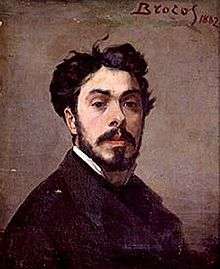Modesto Brocos
Modesto Brocos y Gómez (9 February 1852 – 28 November 1936) was a Spanish painter, and engraver, naturalized Brazilian citizen.
Modesto Brocos | |
|---|---|
 Autorretrato, 1882 | |
| Born | Modesto Brocos y Gómez 9 February 1852 |
| Died | 28 October 1936 (aged 84) Rio de Janeiro, Brazil |
| Nationality | Spanish, Brazilian |
| Known for | painting, engraving, drawing |
| Movement | Realism |
His work covers a wide variety of styles and subjects, and he was the author of several books on painting. He is also notable for his promotion of printmaking in Brazil,[1] especially woodcuts, of which he had been one of his adopted country's first major practitioners during his time at O Mequetrefe.
Biography

He was born in Santiago de Compostela, Galicia, Spain, into a humble family with artistic inclinations. His grandfather and father were writers and his brother was the sculptor Isidoro Brocos,[2] who was also his first teacher at the Academia de Belas Artes in A Coruña. At the age of eighteen, after completing his studies, he moved to Argentina, but wasn't successful there, so he moved again two years later; this time to Brazil, where he eventually found permanent work in Rio de Janeiro illustrating the mildly satirical weekly republican magazine O Mequetrefe (a term that describes a nosy person who is a bit of a scamp). This income enabled him to enter the Academia Imperial de Belas Artes, where he studied under Victor Meirelles and João Zeferino da Costa.[1]
After two years there, he moved to Paris, enrolled at the École des Beaux-Arts and took lessons from Henri Lehmann. He wasn't satisfied with what he was being taught, however, and moved again, to Madrid (where he studied briefly at the Real Academia de Bellas Artes de San Fernando), then on to Rome in 1883, after receiving a fellowship from the government of A Coruña.[2] Once there, he worked with his countryman, Francisco Pradilla and spent five years at the Accademia Chigi.
By 1890, he was exhibiting at the Salon and felt that his education was complete, so he accepted an invitation to teach at the Escola Nacional de Belas Artes (successor to the Imperial Academy) from its Director, Rodolfo Bernardelli. He was able to become a naturalized citizen with little difficulty, and was appointed the Professor of Figurative Drawing there; a position he held for the rest of his life,[1] with a brief leave of absence to create some decorations for the Santiago de Compostela Cathedral.[2]
He died in Rio de Janeiro on 28 November 1936.
References
- Biography @ the Enciclopédia Itaú Cultural.
- DezenoveVinte: Modesto Brocos: A Retórica dos Pintores, by José Luiz da Silva Nunes.
Further reading
Books by Brocos
Others
- Francisco Pablos, Pintores gallegos del novecientos : Serafín Avendaño, Modesto Brocos, Roman Navarro ..., A Coruña, Fundación Pedro Barrié de la Maza : Editorial Atlántico, 1981 ISBN 84-85858-06-9